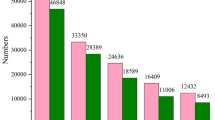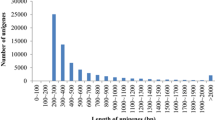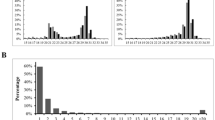Abstract
Although a wide variety of proteins and genes possibly related to the shell formation in bivalve have been identified, their functions have been only partially approved. We have recently performed deep sequencing of expressed sequence tags (ESTs) from the pearl oyster Pinctada fucata using a next-generation sequencer, identifying a dozen of novel gene candidates which are possibly associated with the nacreous layer formation. Among the ESTs, we focused on three novel isoforms (N16-6, N16-7, and N19-2) of N16 and N19 families with reference to five known genes in the families and determined the full-length cDNA sequences of these isoforms. Reverse transcription-polymerase chain reaction revealed that N16-6 was expressed in gill, gonad, adductor muscle, and mantle, whereas N16-7 exclusively in mantle. N19-2 was expressed in all tissues examined. In situ hybridization demonstrated their regional expression in mantle and pearl sac, which well corresponded to those shown by EST analysis previously reported. Shells in the pearl oyster injected with dsRNAs of N16-7 and N19-2 showed abnormal surface appearance in the nacreous layer. Taken together, novel isoforms in N16 and N19 families shown in this study are essential to form the nacreous layer.








Similar content being viewed by others
References
Awaji M, Machii A (2011) Fundamental studies on in vivo and in vitro pearl formation: contribution of outer epithelial cells of peal oyster mantle and pearl sacs. Aqua BioSci Monogr 1:1–39
Endo K, Takeuchi T (2013) Annotation of the pearl oyster genome. Zool Sci 30:779–780
Fabioux C, Corporeau C, Quillien V, Favrel P, Huvet A (2009) In vivo RNA interference in oyster—vasa silencing inhibits germ cell development. FEBS J 276:2566–2573
Fang Z, Feng Q, Chi Y, Xie L, Zhang R (2008) Investigation of cell proliferation and differentiation in the mantle of Pinctada fucata (Bivalve, Mollusca). Mar Biol 153(4):745–754
Fang D, Xu G, Hu Y, Pan C, Xie L, Zhang R (2011) Identification of genes directly involved in shell formation and their functions in pearl oyster, Pinctada fucata. PLoS One 6(7):e21860
Fang D, Pan C, Lin H, Lin Y, Zhang G, Wang H, He M, Xie L, Zhang R (2012) Novel basic protein, PfN23, functions as key macromolecule during nacre formation. J Biol Chem 287(19):15776–15785
Fire A, Xu SQ, Montgomery MK, Kostas SA, Driver SE, Mello CC (1998) Potent and specific genetic interference by double-stranded RNA in Caenorhabditis elegans. Nature 391(6669):806–811
Funabara D, Ohmori F, Kinoshita S, Mizutani S, Ota A, Osakabe Y, Nagai K, Maeyama K, Okamoto K, Kanoh S, Asakawa S, Watabe S (2014) Novel genes participating in the formation of prismatic and nacreous layers in the pearl oyster as revealed by their tissue distribution and RNA interference knockdown. PLoS One 9(1):e84706
Gasteiger E, Hoogland C, Gattiker A, Duvaud S, Wilkins MR, Appel RD, Bairoch A (2005) Protein identification and analysis tools on the ExPASy server. In: Kalker JM (ed) The proteomics protocols handbook. Humana Press, Totowa, pp 571–607
Gehrke N, Nassif N, Pinna N, Antonetti M, Gupta HS, Cölfen H (2005) Retrosynthesis of nacre via amorphous precursor particles. Chem Mater 17(26):6514–6516
Gong N, Li Q, Huang J, Fang Z, Zhang G, Xie L, Zhang R (2008) Culture of outer epithelial cells from mantle tissue to study shell matrix protein secretion for biomineralization. Cell Tissue Res 333(3):493–501
Inoue N, Ishibashi R, Ishikawa T, Atsumi T, Aoki H, Komaru A (2011a) Can the quality of pearls from the Japanese oyster (Pinctada fucata) be explained by the gene expression patterns of the major shell matrix proteins in the pearl sac? Mar Biotechnol 13(1):48–55
Inoue N, Ishibashi R, Ishikawa T, Atsumi T, Aoki H, Komaru A (2011b) Comparison of expression patterns of shell matrix protein genes in the mantle tissues between high- and low-quality pearl-producing recipients of the pearl oyster, Pinctada fucata. Zool Sci 28(1):32–36
Jackson DJ, McDougall C, Woodcroft B, Moase P, Rose RA, Kube M, Reinhardt R, Rokhsar DS, Montagnani C, Joubert C, Piquemal D, Degnan BM (2010) Parallel evolution of nacre building gene sets in molluscs. Mol Biol Evol 27(3):591–608
Jones DB, Zenger KR, Jerry DR (2011) In silico whole-genome EST analysis reveals 2322 novel microsatellites for the silver-lipped pearl oyster, Pinctada maxima. Mar Genomics 4:287–290
Joubert C, Piquemal D, Marie B, Manchon L, Pierrat F, Zanella-Cléon I, Cochennec-Laureau N, Gueguen Y, Montagnani C (2010) Transcriptome and proteome analysis of Pinctada margaritifera calcifying mantle and shell: focus on biomineralization. BMC Genomics 11(1):613
Kinoshita S, Wang N, Inoue H, Maeyama K, Okamoto K, Nagai K, Kondo H, Hirono I, Asakawa S, Watabe S (2011) Deep sequencing of ESTs from nacreous and prismatic layer producing tissues and a screen for novel shell formation-related genes in the pearl oyster. PLoS One 6(6):e21238
Kono M, Hayashi N, Samata T (1999) Molecular mechanism of the nacreous layer formation in Pinctada maxima. Biochem Biophys Res Commun 269:213–218
Liang J, Xie J, Gao J, Xu CO, Yan Y, Jia GC, Xiang L, Xie LP, Zhang RQ (2016) Identification and characterization of the lysine-rich matrix protein family in Pinctada fucata: indicative of roles in shell formation. Mar Biotechnol 18:645–648
Ma JY, Wong KL, Xu ZY, Au KY, Lee NL, Su C, Su WW, Li PB, Shaw PC (2016) N16, a nacreous protein, inhibits osteoclast differentiation and enhances osteogenesis. J Nat Prod 79(1):204–212
Marin F, Luquet G, Marie B, Medakovic D (2008) Molluscan shell proteins: primary structure, origin, and evolution. Curr Top Dev Biol 80:209–276
Masaoka T, Samata T, Nogawa C, Baba H, Aoki H, Kotani T, Nakagawa A, Sato N, Fujiwara A, Kobayashi T (2013) Shell matrix protein genes derived from donor expressed in pearl sac of akoya pearl oysters (Pinctada fucata) under pearl culture. Aquaculture 384-387:56–65
Metzler RA, Evans JS, Killian CE, Zhou D, Churchill TH, Appathurai NP, Coppersmith SN, Gilbert PUPA (2010) Nacre protein fragment templates lamellar aragonite growth. J Am Chem Soc 132(18):6329–6334
Miyamoto H, Miyashita T, Okushima M, Nakano S, Morita T, Matsushiro A (1996) A carbonic anhydrase from the nacreous layer in oyster pearls. Proc Natl Acad Sci U S A 3:9657–9660
Miyamoto H, Endo H, Hashimoto N, Iiyama K, Isowa Y, Kinoshita S, Kotaki T, Masaoka T, Miki T, Nakayama S, Nogawa C, Notazawa A, Ohmori F, Sarashina I, Suzuki M, Takagi R, Takahashi J, Takeuchi T, Yokoo N, Satoh N, Toyohara H, Miyashita T, Wada H, Samata T, Endo K, Nagasawa H, Asakawa S, Watabe S (2013) The diversity of shell matrix proteins: genome-wide investigation of the pearl oyster, Pinctada fucata. Zool Sci 30(10):801–816
Miyazaki Y, Nishida T, Aoki H, Samata T (2010) Expression of genes responsible for biomineralization of Pinctada fucata during development. Comp Biochem Physiol B 155:241–248
Montagnani C, Marie B, Marin F, Belliard C, Riquet F, Tayale A, Zanella-Cléon I, Fleury E, Gueguen Y, Piquemal D, Cochennec-Laureau N (2011) Pmarg-Pearlin is a matrix protein involved in nacre framework formation in the pearl oyster Pinctada margaritifera. Chembiochem 12(13):2033–2043
Nogawa C, Baba H, Masaoka T, Aoki H, Samata T (2012) Genetic structure and polymorphisms of the N16 gene in Pinctada fucata. Gene 504(1):84–91
Petersen TN, Brunak S, von Heijne G, Nielsen H (2011) SignalP 4.0: discriminating signal peptides from transmembrane regions. Nat Methods 8(10):785–786
Punta M, Coggill PC, Eberhardt RY, Mistry J, Tate J, Bourenell C, Pang N, Forslund K, Ceric G, Clements J, Heger A, Holm L, Sonnhammer EL, Eddy SR, Bateman A, Finn RD (2012) The Pfam protein families database. Nucleic Acids Res 40(D1):D290–D301
Samata T, Hayashi N, Kono M, Hasegawa K, Horita C, Akera S (1999) A new matrix protein family related to the nacreous layer formation of Pinctada fucata. FEBS Lett 462(1-2):225–229
Sarashina I, Endo K (2006) Skeletal matrix proteins of invertebrate animals: comparative analysis of their amino acid sequences. Paleontol Res 10(4):311–336
Sato Y, Inoue N, Ishibashi R, Obata M, Aoki H, Atsumi T, Komaru A (2013) Pearl microstructure and expression of shell matrix protein genes MSI31 and MSI60 in the pearl sac epithelium of Pinctada fucata by in situ hybridization. PLoS One 8(1):e52372
Sudo S, Fujikawa T, Nagakura T, Ohkubo T, Sakaguchi K, Tanaka M, Nakashima K, Takahashi T (1997) Structures of mollusc shell framework proteins. Nature 387(6633):563–564
Suzuki M, Murayama E, Inoue H, Ozaki N, Tohse H, Kogure T, Nagasawa H (2004) Characterization of prismalin-14, a novel matrix protein from the prismatic layer of the Japanese pearl oyster (Pinctada fucata). Biochem J 382(1):205–213
Suzuki M, Saruwatari K, Kogure T, Yamamoto Y, Nishimura T, Kato T, Nagasawa H (2009) An acidic matrix protein, Pif, is a key macromolecule for nacre formation. Science 325(5946):1388–1390
Takeuchi K, Kawashima T, Koyanagi R, Gyoja F, Tanaka M, Ikuta T, Shoguchi E, Fujiwara M, Shinzato C, Hisata K, Fujie M, Usami T, Nagai K, Maeyama K, Okamoto K, Aoki H, Ishikawa T, Masaoka T, Fujiwara A, Endo K, Endo H, Nagasawa H, Kinoshita S, Asakawa S, Watabe S, Satoh N (2012) Draft genome of the pearl oyster Pinctada fucata: a platform for understanding bivalve biology. DNA Res 19(2):117–130
Tsukamoto D, Sarashina I, Endo K (2004) Structure and expression of an unusually acidic matrix protein of pearl oyster shells. Biochem Biophys Res Commun 269:213–218
Wang N, Kinoshita S, Riho C, Maeyama K, Nagai K, Watabe S (2009) Quantitative expression analysis of nacreous shell matrix protein genes in the process of pearl biogenesis. Comp Biochem Physiol B 154:346–350
Wang N, Kinoshita S, Nomura N, Riho C, Maeyama K, Nagai K, Watabe S (2012) The mining of pearl formation genes in pearl oyster Pinctada fucata by cDNA suppression subtractive hybridization. Mar Biotechnol 14:177–188
Watabe S (2013) The importance of total genome database in research on Akoya pearl oyster. Zool Sci 30:781–782
Watabe S, Maeyama K, Nagasawa H (eds) (2013) Recent advances in pearl oyster. TERRAPUB, Tokyo
Weiss IM, Tuross N, Addadi L, Weiner S (2002) Mollusc larval shell formation: amorphous calcium carbonate is a precursor phase for aragonite. J Exp Zool 2293:478–491
Yano M, Nagai K, Morimoto K, Miyamoto H (2007) A novel nacre protein N19 in the pearl oyster Pinctada fucata. Biochem Biophys Res Commun 362(1):158–163
Zhang H, He M (2011) Quantitative expression of shell matrix protein genes and their correlations with shell traits in the pearl oyster Pinctada fucata. Aquaculture 314(1-4):73–79
Zhang C, Zhang R (2006) Matrix proteins in the outer shells of molluscs. Mar Biotechnol 8(6):572–586
Author information
Authors and Affiliations
Corresponding author
Electronic supplementary material
Supplementary Table 1
(DOCX 15 kb)
Supplementary Table 2
(XLSX 10 kb)
Supplementary Table 3
(DOCX 18 kb)
Supplementary Table 4
(DOCX 18 kb)
Supplementary Table 5
(DOCX 21 kb)
Supplementary Table 6
(DOCX 18 kb)
Supplementary Table 7
(XLSX 10 kb)
Supplementary Fig. 1
The DNA nucleotide sequences of N16 isoforms, N16–1, N16–2, N16–3, N16–5, N16–6 and N16–7, from the pearl oyster Pinctada fucata. (PPTX 60.4 kb)
Supplementary Fig. 2
The DNA nucleotide sequences of N19 isoforms, N19 and N19–2, from the pearl oyster Pinctada fucata. (PPTX 61.2 kb)
Rights and permissions
About this article
Cite this article
Ohmori, F., Kinoshita, S., Funabara, D. et al. Novel Isoforms of N16 and N19 Families Implicated for the Nacreous Layer Formation in the Pearl Oyster Pinctada fucata. Mar Biotechnol 20, 155–167 (2018). https://doi.org/10.1007/s10126-017-9793-1
Received:
Accepted:
Published:
Issue Date:
DOI: https://doi.org/10.1007/s10126-017-9793-1




